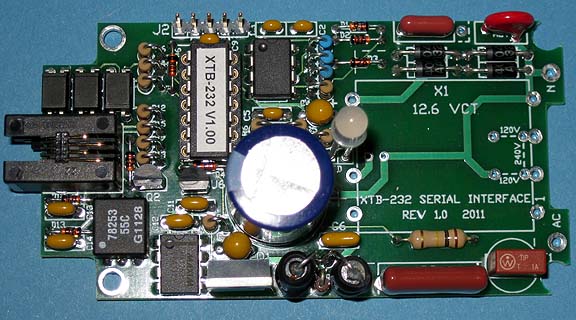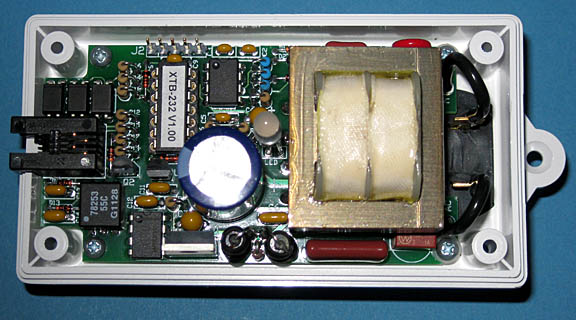
XTB-232 Assembled PCB before installing transformer X1
XTB-232 Assembly Notes
2/8/14
Please check for the latest version before beginning assembly.
The XTB-232 has a densely populated circuit board. Assembly requires experience working with small components, and also the ability to correctly identify component values. A low-wattage soldering iron with a 1/16" tip is recommended. Care must be taken to not overheat the semiconductor devices.
BEFORE ASSEMBLY
A few people have had trouble identifying components. The zener diode has been packaged with the other semiconductors to help identify it. It is best to keep it packaged until you are ready to install it. You will need a magnifier to read the some of the part numbers. Be sure you have correctly identified ALL the diodes before you begin installing them. I also recommend sorting out the capacitors and resistors before soldering any onto the board. Be careful to correctly identify the 10K and 47K 5% resistors (orange 3rd band). The 1% resistors are blue and have an additional color band, so be careful identifying them.
PRINTED CIRCUIT BOARD ASSEMBLY:
Please read these Detailed Assembly Instructions before beginning actual assembly to avoid any problems. Also, please refer to the parts list, board layout, and high-resolution photograph of the assembled board while assembling your own unit:
Do not try to assemble the XTB-232 with a high wattage soldering iron having a tip larger than 1/8". A variable temperature iron with a 1/16" tip works well. I recommend installing all diodes and resistors that mount flush to the board first, followed by the DIP integrated circuits and DIP socket for U2. Many components stand on end to save space. Work your way up to larger and larger components. Leave the electrolytic capacitor, transformer, and LED for last. The XTB-232 Board Photograph shows the board before the transformer is mounted.
Things to watch out for:
1) The XTB-232 is a tight fit in the Polycase. The board mounts between the standoffs at the transformer end to give enough clearance for the transformer to just squeeze in. The transformer must be mounted flush to the circuit board, and any required jumpers placed on the underside of the board.
2) A dual-primary transformer may be supplied with the XTB-232. That can be identified by it having 4 pins on both sides. A dual-primary transformer requires two short jumpers to be installed on the reverse side of the board to connect the primaries in parallel for 120V operation. The connections are diagramed on the silkscreen. Cut-off component leads can be used for both of the short jumpers. Be sure to cut these leads flush with the top surface of the board so they donít interfere with the transformer. Note that for use on 240V, both windings must be connected in series with a single jumper.
3) There is no extra clearance between the transformer and the top cover. The transformer must be firmly seated to the PCB before soldering it down. If you have installed jumpers for a dual primary transformer, they must be snipped flush with the top of the PCB so they don't contact the transformer. Depending on the transformer manufacturer, the pin numbers may be labeled on the bobbin near the pins, or there may be a mark at pin 1. Pin 1 should be inserted into the pad adjacent to the fuse.
4) The dot at pin 1 of the opto-isolators U3-U5 may be difficult to see. They may also have a rib in the plastic on the pin 1-2 side. You can verify their orientation is correct by comparing with the high-resolution photo linked above.
5) C4 and C7 are polarized tantalum capacitors. Be very careful to get the polarity correct. The positive (+) lead is marked "+", and may also have a long vertical line.
6) The LED is mounted full-length with sleeving over both pins. The parts kit should contain a 2" length of clear sleeving. Cut that exactly in half and trim slightly so the shortest lead extends just through the circuit board. The longest lead goes into the + pad. When the cover is installed, the LED should slip into the clear lens snapped into the cover.
7) J2 is a programming header that is not normally needed for the kit version.
XTB-232 CHANGES FOR 240V 50Hz:
R9 is 330K 1/2W, and the MOV is 275V for the 240V version. Also, C1 and C8 must be rated for 600VDC or 250VAC
The transformer primaries must be wired in series for 240V with a cut-off component lead. (Use the small holes).
The 240V unit uses a different version of the same case used for the 120V unit that does not have the 120V power plug molded into the base. The mounting standoffs in the 240V base are in different locations, so there is a trick to using it. When you install your power cord, leave the leads extend about 1/4" (7mm) from the bottom of the board. They will slip into the two standoffs adjacent to the power cord inlet. Also note that you will have to cut the pins on several devices flush with the circuit board so they don't conflict with the other mounting standoffs. The board should be held tightly in place when the cover is installed. You may have to shave a tiny bit off the standoffs at the transformer end so the cover will fully seat. Don't cut too much off because the cover holds the board in position.
RECOMMENDED ASSEMBLY ORDER:
D1, D2, D7, D12, D13 (1N4148)
D3 (zener)
D4, D5, D6 (BAT43)
D8, D9, D10, D11 (1N4002-4)
R9 (Note: R9 is 330K in the 240V 50Hz unit)
Add 120V transformer jumpers on back if transformer has a dual primary (8 pins)
NOTE: for 240V install single jumper as shown.
NOTE: snip jumpers flush with top of board before installing transformer
U3, U4, U5 (Note that U3 is reversed from U4 & U5)
U1, U7
U2 socket
C2, C3 (330pF)
C5, C9
C6, C11, C12, C13, C14
NOTE: either .1uF or .47uF may be supplied for C13 and C14
X2
F1
R1, R2, R3, R4, R5, R6, R10 (R1-R3 are 1%)
NOTE: 220 ohm R10 should look like all the other 1/4W carbon film resistors
R7, R11, R12, R13, R14, R15, R16, R17
NOTE: no 1/4W resistors except the R8 carbon composition should be left
C4, C7 (C7 is 35V & be sure of polarity)
C1, MOV
J2 (5-pin header)
J1 (carefully press into board until fully seated)
C8
R8
L1, L2
Q2 (2N2222A - be careful to install adjacent to J1)
U6 (78L05 - small regulator that looks like a transistor)
Q1 (metal tab facing board edge)
C10 (be sure of polarity)
X1 Transformer (pin 1 at corner near the fuse)
LED (cut sleeving in half, insulate leads, mount full height with longer lead at +)
Plug U2 into socket (be sure the notched end faces J2)

XTB-232 Assembled PCB before installing transformer X1
INTERWIRING & FINAL ASSEMBLY:
IMPORTANT: The Polycase base must be modified to prevent conflict between the XTB-232 circuit board and the AC plug ground pin. That extension will be removed from bases shipped with XTB-232 kits. If your base has not been modified, use a rotary tool with a small cutoff disc to remove the internal extension of the ground pin so that it is flush with the plastic base. Also cut off the ground tab even with the plastic case since that is not used. It is unfortunate that Polycase does not make a version of this case with a 2-prong plug.
Cut the wire into two 2" lengths, strip 1/4 of insulation from each end and tin. Solder one end of each wire to the top of the PCB at locations marked AC and N, and trim the excess flush with the bottom of the board.

Completed XTB-232 PCB assembly
Carefully inspect the board for any poor solder connections. Verify all diodes and polarized capacitors are installed in the correct orientation. Mount the board to the base using 4 screws. Since the board sits between the mounting standoffs at the transformer end, use the two insulating washers to hold the board in place.
Connect the two free wires to the adjacent AC plug prongs, and solder.
Make sure the LED is exactly vertical so it will slip into the lens when the cover is attached. If the case doesn't fit over the transformer, the edges of the bobbin can be rounded slightly with a file or wire cutter to fit under the case. (Be careful not to get too close to the windings.) Attach the cover with the 4 black self-tapping screws.
Add the XTB-232 label to the flat area of the base.
TEST & OPERATION:
As a final check before applying power, verify the resistance between the two plug prongs is about 400 ohms. If it reads much lower, the transformer may have been installed backwards.
To verify your XTB-232 is operational, plug it into an AC outlet. The LED should glow dim green. Then send a command from any X10 transmitter, and the LED should flash brighter green to indicate it has received the command. Red flashes indicate various error conditions. A brief red flash when the unit first powers up is not unusual. If the LED doesn't light up at all, or it flashes red frequently, then it is likely something is wired wrong.
Now that your XTB-232 is operational, just connect it to your PC using the same cable that previously plugged into the CM11A. Your automation software should function the same as it would if it were working through a real CM11A.
Please contact me if you have any questions at: jeff@jvde.us
If you don't receive a response within 24 hours, try: xtbjeff@gmail.com
JV Digital Engineering Home Page
[XTB & XTB-II/R Overview] [XTB Home Page] [XTB Ordering Info] [X10 Troubleshooting Info]